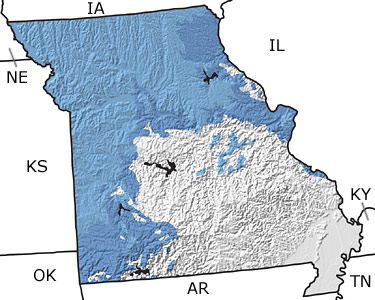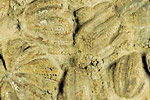

The Carboniferous in Missouri, US |
||||||||||||||||||||||||||||||||||||||||||||||||||||||||||||||
|
||||||||||||||||||||||||||||||||||||||||||||||||||||||||||||||
Paleontology and geologyMost of the surface rocks in western and northwestern Missouri are Carboniferous in age. Early Carboniferous (Mississippian) rocks are exposed in a band that extends from the southwestern corner of the state, northeast across central Missouri, and up the eastern side along the Mississippi River. Most of these rocks are limestones, formed from limy sediments deposited on the floor of a warm shallow sea. These rocks are famous for their fossil remains of crinoids, sea urchins, and corals, and contain large, economically important lead and zinc deposits. Missouri's state fossil, the crinoid Delocrinus missouriensis, is found in some of these rocks. Exposures of Late Carboniferous (Pennsylvanian) rocks are quite extensive in northwestern Missouri and occur below the surface in more than two thirds of the counties in the state. Repeating patterns of sediment deposition (marine limestone and shale, followed by non-marine sandstone, shale, and coal) indicate that a shallow sea advanced and retreated numerous times over this part of the state. Approximately 1,500 of Missouriís more than 5,300 caves occur in Mississippian-age rocks. A variety of fossil plants, such as ferns, seed ferns, Calamites, scale trees, and early conifers, as well as trackways and bones of amphibians, occur in the terrestrial rocks. Fossils of cephalopods, clams, and gastropods are the dominant marine fossils. |
||||||||||||||||||||||||||||||||||||||||||||||||||||||||||||||
Links to more on the Carboniferous in Missouri |
||||||||||||||||||||||||||||||||||||||||||||||||||||||||||||||
|
Education and Exhibits | Research and Collections Education and ExhibitsResearch and Collections
|
||||||||||||||||||||||||||||||||||||||||||||||||||||||||||||||
|
site tour |
about the site |
site map |
site credits |
page credits |
help |
FAQs |
contact |
||



